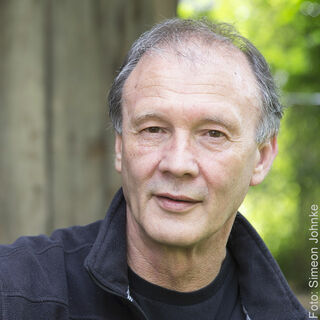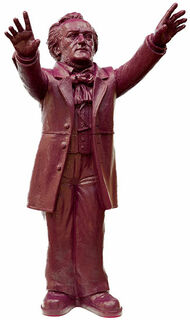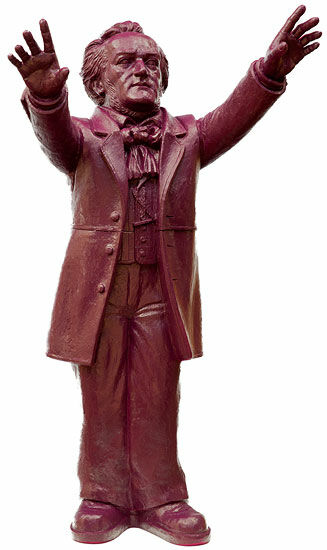Sculpture "Richard Wagner", signed version, purple violet
Sculpture "Richard Wagner", signed version, purple violet
Quick info
Made in Germany | limited, 200 copies | numbered | signed | plastic | size 42 x 102 x 60 cm | weatherproof
Detailed description
Sculpture "Richard Wagner", signed version, purple violet
On the anniversary of Richard Wagner's 200th birthday, 500 Wagner figurines accompanied the festival in the Festspielpark and in the city centre of Bayreuth from 23 July to 28 August 2013. "Clustering in one location, or scattered over the entire city, my sculptural projects become visual as well as tangible obstacles. They are meant to make people think, to make them pause for a moment. In this way, I would like to trigger social communication." (Ottmar Hörl)
Limited edition of 200 copies. Numbered and signed edition in four colour variations, made of weatherproof, unbreakable and non-toxic plastic in a rotational moulding process in Germany. All ingredients come from Germany and are subject to constant quality control. Size 42 x 102 x 60 cm. Version purple violet.
Producer: ARTES Kunsthandelsgesellschaft mbH, Bödekerstraße 13, 30161 Hannover, Deutschland E-Mail: info@kunsthaus-artes.de

About Ottmar Hörl
Ottmar Hörl (born 1950) is one of the most important contemporary German artists.
His sculptural work deals with the theme of standardisation and the equalisation of everyday objects that surround us in so many ways in our lives. But he does it in an extremely humorous way, and his "exhibitions" resemble magnificent spectacles when, for example, he "carries" a giant swarm of owls to Athens, sets up hundreds of bears in front of the Brandenburg Gate or displays 1,000 meerkats on a "staff outing" - all made of brightly coloured plastic.
"Concentrated in a square or distributed in the urban space, my installations become visual as well as tangible obstacles. They are meant to trigger reflection, a moment of pause."
His most famous action was dedicated to the artist Dürer and his world-famous watercolour of a hare. In 2003, no more and no less than 7,000 rabbits filled the main market square in Nuremberg for the "Great Rabbit Piece".
From 1975 to 1979 Ottmar Hörl studied at the Städelschule Academy of Fine Arts in Frankfurt am Main, and from 1981 at the Düsseldorf Academy of Fine Arts as a student of Klaus Rinke. In 1985 he founded the group "Formalhaut" with the architects Gabriela Seifert and Götz G. Stöckmann. In the early 1990s, Hörl was a visiting professor at the Graz University of Technology. Since 1999 he has held a professorship for fine arts at the Academy of Fine Arts Nuremberg, and between October 2005 and October 2017 he was president of the academy.
Through his works, Hörl is engaged with the aesthetics of everyday culture. He defines the term as an "organisational principle" and detects this principle in his environment, in which many objects of daily use are standardised and normed.
His works can be found in many national and international collections. Ottmar Hörl lives and works in Nuremberg and Wertheim.
Collective term for all casting processes that ars mundi carries out with the help of specialised art foundries.
Stone Casting
Similar to artificial marble, with the difference that instead of marble powder, the stone to be replicated is used in powder form.
Bonded Bronze (Cold-Cast-Bronze)
Bronze powder is polymer-bonded. Through special polishing and patination techniques, the surface of the cast takes on an appearance similar to that of bronze.
Imitation Wood
In order to guarantee absolute fidelity to the original, an artificially manufactured imitation wood is used as a base material that features typical wood characteristics: density, workability, colour, and surface structure.
Ceramic Mould Casting
Ceramic mould casting usually requires the use of casting clay, which is then fired and optionally glazed. Instead of the usual rubber moulds, plaster moulds are often used in ceramic casting and porcelain production.
Cast Bronze (Lost-Wax-Casting)
For the cast bronze, the thousand-year-old lost-wax technique is used. It's the best, but also the most complex method of producing sculptures.
Term for an art object (sculpture, installation) that, according to the artist’s intention, is produced in multiple copies within a limited and numbered edition.
Multiples enable the "democratization" of art by making the work accessible and affordable for a wider audience.
A plastic work of sculptural art made of wood, stone, ivory, bronze or other metals.
While sculptures made of wood, ivory, or stone are carved directly from the material block, in bronze casting, a working model is prepared at first. Usually, it is made of clay or other easily mouldable materials.
The prime time of sculpture after the Greek and Roman antiquity was the Renaissance. Impressionism gave a new impulse to the sculptural arts. Contemporary artists such as Jorg Immendorf, Andora, and Markus Lupertz also enriched sculptures with outstanding works.


